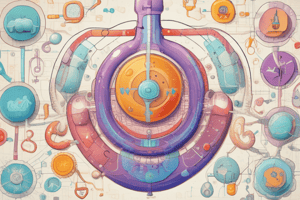Podcast
Questions and Answers
What is the central molecule for carbohydrate metabolism?
What is the central molecule for carbohydrate metabolism?
Glucose
All cells can utilize fructose for energy production.
All cells can utilize fructose for energy production.
False (B)
What is the normal fasting blood glucose level range in mg/dl?
What is the normal fasting blood glucose level range in mg/dl?
70-100
Which metabolic pathway involves the oxidation of glucose to pyruvate?
Which metabolic pathway involves the oxidation of glucose to pyruvate?
Which of the following is a fate of glucose in the fed state?
Which of the following is a fate of glucose in the fed state?
How many ATP are produced from glycolysis under anaerobic conditions?
How many ATP are produced from glycolysis under anaerobic conditions?
What is the term for the synthesis of glucose from non-carbohydrate compounds?
What is the term for the synthesis of glucose from non-carbohydrate compounds?
The process of synthesis of glycogen from glucose is known as ______.
The process of synthesis of glycogen from glucose is known as ______.
Study Notes
Overview of Carbohydrate Metabolism
- Glucose is a primary molecule in carbohydrate metabolism.
- Fructose and Galactose integrate into various metabolic pathways.
- All cells possess the ability to utilize glucose for energy.
- Insulin and transporters predominantly mediate glucose uptake from blood to cells.
- The liver functions as the central hub for carbohydrate metabolism, regulating blood glucose levels.
- Normal fasting blood glucose levels range from 70 to 100 mg/dl.
Major Pathways of Carbohydrate Metabolism
- Glycolysis: Converts glucose into pyruvate and lactate, yielding ATP.
- Citric Acid Cycle (TCA Cycle): Oxidizes acetyl CoA to carbon dioxide.
- Gluconeogenesis: Synthesizes glucose from non-carbohydrate sources like amino acids, glycerol, and lactate.
- Glycogenesis: Converts glucose to glycogen for storage.
- Glycogenolysis: Breaks down glycogen back into glucose.
- Hexose Monophosphate Shunt: Alternative pathway for glucose oxidation that generates NADPH and ribose-5-phosphate.
Fates of Glucose
- Fed State:
- Stored as glycogen in the liver and skeletal muscle.
- Converted into lipids in adipose tissue.
- Fasted State:
- Used for energy production.
- Newly synthesized glucose from non-carbohydrate sources.
Immediate Post-Meal Metabolism
- Four primary metabolic pathways become active immediately after eating:
- Provides immediate energy source.
- Engages the pentose phosphate pathway.
- Initiates glycogen synthesis in liver and muscles.
- Serves as a precursor for triacylglycerol synthesis.
Glycolysis
- Consists of reactions converting glucose or glycogen into pyruvate or lactate while producing ATP.
- Occurs in all body cells, with enzymes situated in the cytoplasm.
- Divided into:
- Aerobic Glycolysis: Occurs with oxygen, producing pyruvate which is further oxidized to CO2 and water.
- Anaerobic Glycolysis: Occurs without oxygen, yielding lactate or ethanol as end products.
- Vital for ATP production in tissues like erythrocytes that lack mitochondria.
- Crucial energy source for the brain, which is dependent on glucose.
Steps and ATP Production in Glycolysis
- Reaction: Glucose + 2 ADP + 2 Pi → 2 Pyruvate + 2 ATP + 2 H2O.
- ATP yield:
- Anaerobic conditions: Produces 2 ATP.
- Aerobic conditions: Produces up to 38 ATP.
Citric Acid Cycle (TCA Cycle)
- Central metabolic pathway for oxidation of acetyl CoA to CO2 and water.
- Key features:
- Connects most metabolic pathways directly or indirectly.
- Enzymes are localized in the mitochondrial matrix.
- Involves the combination of acetyl CoA with 4-carbon oxaloacetate to form a 6-carbon citrate.
Energetics of the TCA Cycle
- Generates a total of 12 ATP from one acetyl CoA.
- Each NADH molecule equates to 3 ATP, while each FADH2 equals 2 ATP.
- Complete glucose oxidation pathway yields approximately 38 ATP when considering substrate-level phosphorylation and the electron transport chain.
Gluconeogenesis
- Converts non-carbohydrate compounds into glucose.
- Major substrates include lactate, glucogenic amino acids, and glycerol.
- Primarily occurs in the liver and to some extent in the kidney cortex.
- Essential for supplying glucose to the brain, CNS, erythrocytes, and kidney medulla, especially under anaerobic conditions.
Glycogenesis
- Process of synthesizing glycogen from glucose.
- Primarily occurs in muscle and liver cells.
- Key initial reaction involves converting glucose to glucose-6-phosphate for storage and later mobilization.
Studying That Suits You
Use AI to generate personalized quizzes and flashcards to suit your learning preferences.
Description
This quiz explores the essential role of glucose in carbohydrate metabolism, including the metabolism of fructose and galactose. It will cover glucose uptake mechanisms, the role of insulin, and the liver's function in maintaining blood glucose levels. Test your understanding of key biochemical processes related to energy production.




